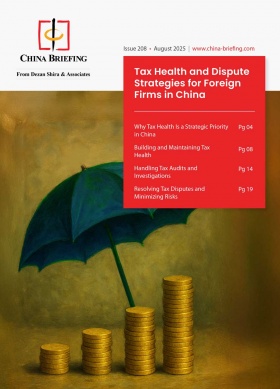China Moves Toward Absolute Emissions Cap in Carbon Trading System
China’s carbon trading emissions cap marks a major shift in the country’s climate policy. A new directive introduces absolute limits on emissions under the national ETS, replacing the previous intensity-based approach. This article explores the implications for carbon pricing, industry compliance, and China’s broader decarbonization goals.
On August 25, 2025, the General Office of the Central Committee of the Chinese Communist Party (CCP), the CCP’s decision-making body, and the General Office of the State Council, the State Council’s administrative organ, released a new set of opinions to expand China’s carbon trading market in pursuit of lower-carbon development.
The document, titled the Opinions on Promoting Green and Low-Carbon Transformation and Strengthening the Construction of the National Carbon Market (hereinafter the “Opinions”), lays out a roadmap for accelerating the development of a unified national emissions trading market. A key directive is the establishment of an total emissions cap for industries covered by the national emissions trading system (ETS), shifting the market away from its current intensity-based approach toward one that limits absolute emissions. The Opinions also call for setting a cap on the volume of carbon emissions allowances (CEAs) and gradually increasing the share of paid allowances relative to free ones.
These measures mark a significant step toward enhancing the effectiveness of China’s ETS. By moving from efficiency-based benchmarks to hard limits on both emissions and allowance volumes, the system will be better positioned to generate meaningful carbon prices, create stronger incentives for companies to decarbonize, and ensure that overall emissions are brought down in line with China’s carbon peak and neutrality goals.
How does China’s ETS work?
China’s ETS officially launched in July 2021 in Shanghai, following a decade of pilot programs in selected municipalities and provinces. At launch, it became the largest carbon trading market in the world in terms of emissions coverage, initially applying to around 2,000 entities in the power generation sector and covering only carbon dioxide (CO2) emissions. This initial scope represented approximately 4 billion tons of CO2 emissions.
The ETS covers key emissions units, companies whose annual greenhouse gas (GHG) emissions exceed 26,000 tons of CO2 equivalent (CO2e). These entities are responsible for controlling their emissions, reporting verified carbon data, surrendering allowances, disclosing trading activity, and complying with oversight from provincial and national ecological and environmental authorities.
In 2024, the ETS coverage was expanded to include the cement, steel, and aluminum smelting industries, adding approximately 1,500 new entities and an additional 3 billion tons of CO2e. For these industries, allowances are initially allocated based on verified emissions reports, with a phased transition to intensity-based allocation tied to production output planned for 2025 to 2026. The GHGs covered by the ETS for these industries were also expanded to include carbon tetrafluoride (CF4) and carbon hexafluoride (C2F6).
Limitations of China’s ETS
Since 2021, companies in the power generation sector have received free CEAs based on their electricity and heat output and government-set efficiency benchmarks. Under this system, more efficient plants can receive enough allowances, or in some cases extra allowances that they can sell, while less efficient plants are given fewer than required, forcing them to buy additional CEAs. This is designed to create a financial incentive to improve efficiency.
In 2024, the first year of their inclusion in the ETS, companies in the cement, steel, and aluminum smelting sectors received allowances based on verified emissions, ensuring relatively easy compliance. For the 2025 to 2026 period, allocation will shift to an intensity-based approach tied to production output.
However, this system thus far has proved ineffective at incentivizing decarbonization. The reliance on an intensity and efficiency-based system without a total emissions cap means that companies can continue to maintain high production without significantly reducing absolute emissions.
Moreover, no total CEA caps are set for any of the industries covered by the ETS, with allowances instead allocated in proportion to actual output and based on prescribed carbon-intensity benchmarks. This means that companies can receive as many allowances as needed to remain compliant, creating oversupply and driving down prices.
The High-Level Commission on Carbon Prices, a World Bank initiative, found in 2017 that carbon credit prices had to be between US$40 and US$80 per ton of CO2 by 2020, and between US$50 and US$100 per ton of CO2 by 2030, if the world is to limit global warming to well below 2°C as outlined in the Paris Agreement.
China’s CEA prices have never reached anywhere near this level, and remain far below prices in more mature markets, such as the EU. Closing CEA prices in China reached an all-time high of RMB 104.5 (US$14.6) per ton of CO2 in November 2024. Moreover, prices have fallen considerably in recent months, dropping to a monthly average closing price of RMB 71 (US$9/94) in August of this year, a year-on-year decrease of 21.7 percent.
Another limitation to China’s ETS is the same issue that hampers the effectiveness of all carbon markets around the world: insufficient global interconnectivity leading to carbon leakage. At present, this is a smaller concern for China, given the relatively narrow coverage of the ETS, abundance of free allowances, and low carbon prices. However, if the government seeks to tighten the market through stricter CEA caps and expanded sector coverage, carbon leakage to markets with looser environmental regulations could pose a more significant challenge.
Setting a total emissions cap
The new Opinions address some of the current problems with China’s ETS. The headline directive is the setting of a total emissions cap for industries covered, with a planned shift from an intensity-based control system to an emissions-based control system. This total emissions cap will be based on national GHG emission control targets and the dual carbon emission control requirements. It will also take into account the need to safeguard the country’s energy security, maintain industrial and supply chain stability, and protect living standards.
Setting an overall emissions cap will be crucial to improving the effectiveness of the ETS. As mentioned above, the current intensity-based allocation system allows companies to maintain or even increase production without substantially reducing absolute emissions, meaning that efficiency improvements alone are insufficient to drive real decarbonization. By introducing a firm total emissions cap, the ETS can create binding limits on sector-wide emissions, providing stronger incentives for companies to invest in low-carbon technologies and reduce overall greenhouse gas output.
Expanding ETS coverage to all major industries
The Opinions state that by 2027, the ETS will be expanded to cover all major carbon-emitting industrial sectors. While they do not specify which industries these will be, they could include high-emission sectors such as petrochemicals, nonferrous metals, building materials, and aviation.
The current ETS covers only around 60 percent of China’s carbon emissions. Expanding coverage to all major industries is essential to ensure that emission reductions are achieved across the entire economy, not just in the power sector and a handful of heavy industries. Broader participation will also increase the scale and liquidity of the carbon market, strengthen price signals, and make the ETS a more powerful driver of China’s long-term decarbonization goals.
Capping the volume of CEAs
The Opinions also call for capping the total volume of CEAs, requiring the government to set the medium- and long-term market CEA control targets based on economic and social development, industry characteristics, and the costs of low-carbon transition. Industries with relatively stable total carbon emissions will be prioritized for a CEA cap by 2027. By 2030, the ETS is expected to transition to a system governed by a firm cap on CEA volume, incorporating a mix of free and paid allowances.
Moreover, while the Opinions maintain the use of free CEAs in combination with paid CEAs, it calls for gradually increasing the proportion of paid CEAs. It also calls for establishing CEA reserves and market regulation mechanisms to balance market supply and demand and enhance market stability and liquidity.
Setting a CEA cap for all industries covered by the ETS will help to drive up the price of CEAs and create more of a financial incentive to reduce emissions rather than rely on free allocations. A cap on allowances, combined with a gradual shift toward paid CEAs, will also strengthen the market’s role in allocating resources, rewarding companies that adopt cleaner technologies, and penalizing those that fail to control their carbon output. Over time, these changes are expected to increase market liquidity and stability, while ensuring that the ETS evolves into a more effective tool for driving decarbonization across China’s economy.
Expanding the CCER
Beyond the changes to the ETS, the Opinions provide guidance on the development of the voluntary emissions reduction trading market, as well as the China Certified Emissions Reduction (CCER) program.
The CCER program is a voluntary carbon credit system launched at the beginning of 2024, designed to complement the ETS by incentivizing clean energy development and broadening market participation beyond high-emission enterprises.
The program enables companies in all sectors to generate and trade carbon reduction credits from verified emission-reduction projects. These currently cover 10 fields: afforestation, solar thermal power, offshore wind power, mangrove creation, energy-saving highway tunnel lighting systems, low-concentration coal mine gas, wind exhaust gas utilization, biomass power generation, and oil and gas methane recovery from onshore and offshore oilfields.
The Opinions set two main goals for China’s voluntary carbon trading market: expanding the CCER to cover emission-reduction projects across “all key fields” by 2027, and establishing a national voluntary greenhouse gas emission reduction trading market by 2030.
Enhancing international cooperation
The Opinions highlight the need to improve offsetting rules, enhance the international recognition of Chinese carbon credits, and ensure that the CCER can support companies in meeting international compliance obligations and product-level carbon neutrality claims. They also call for deeper participation in Paris Agreement carbon market mechanisms, stronger dialogue with other countries, and progress toward the mutual recognition of standards, methodologies, and data.
International recognition is critical to the credibility and long-term effectiveness of the CCER. At present, the program functions mainly as a domestic offsetting tool, but its value and integrity will be strengthened if CCER credits can be traded or recognized internationally, as is encouraged under Article 6 of the Paris Agreement. Such alignment would give Chinese companies greater flexibility in meeting compliance and voluntary targets and help China position itself as a leader in global carbon market development.
In an interview with 21st Century Business Herald, Director General of the Department of Climate Change at the MEE, Xia Yingxian, noted that “international carbon market construction is a long-term and difficult task” but one in which China already plays a pivotal role. He emphasized that China’s carbon markets can both serve to achieve China’s domestic “dual carbon” goals, while also acting as a channel for the country’s participation in global climate governance. According to Xia, multiple countries have already sought to engage with China on carbon market cooperation, and China is “actively promoting cross-border carbon trading research and system-building” to ensure its standards and practices can gain international recognition.
Implications for foreign companies
The Opinions carry important implications for foreign companies operating in China. As the ETS expands to cover all major emitting industries by 2027, foreign firms in sectors that could be affected, in particular petrochemicals, nonferrous metals, and aviation, will come under the purview of the ETS. This will mean having to comply with allowance allocation, as well as various reporting and verification requirements.
The introduction of a total emissions cap and a cap on the volume of CEAs is expected to push up carbon prices over time, particularly as the share of free allowances is gradually reduced. Affected companies should therefore anticipate higher compliance costs and factor these into investment and operational decisions in China.
The expansion of the system, as well as the shift toward stricter caps, will likely also bring more rigorous carbon accounting and oversight. Companies can expect an increased compliance burden, with tighter monitoring, verification, and reporting standards. Foreign companies should prepare by strengthening internal carbon management systems and ensuring readiness to meet China’s evolving requirements, while also considering how participation in China’s ETS may align with their global climate strategies.
At the same time, the evolving ETS presents opportunities for efficient and low-carbon companies. Firms that have already invested in cleaner technologies or improved operational efficiency may benefit from surplus allowances that can be sold in the market, generating additional revenue. Participation in the ETS and voluntary carbon markets such as the CCER can also help foreign companies enhance their environmental credentials, demonstrate leadership in sustainability, and align their China operations with global climate commitments.
About Us
China Briefing is one of five regional Asia Briefing publications. It is supported by Dezan Shira & Associates, a pan-Asia, multi-disciplinary professional services firm that assists foreign investors throughout Asia, including through offices in Beijing, Tianjin, Dalian, Qingdao, Shanghai, Hangzhou, Ningbo, Suzhou, Guangzhou, Haikou, Zhongshan, Shenzhen, and Hong Kong in China. Dezan Shira & Associates also maintains offices or has alliance partners assisting foreign investors in Vietnam, Indonesia, Singapore, India, Malaysia, Mongolia, Dubai (UAE), Japan, South Korea, Nepal, The Philippines, Sri Lanka, Thailand, Italy, Germany, Bangladesh, Australia, United States, and United Kingdom and Ireland.
For a complimentary subscription to China Briefing’s content products, please click here. For support with establishing a business in China or for assistance in analyzing and entering markets, please contact the firm at china@dezshira.com or visit our website at www.dezshira.com.
- Previous Article China Tech Cities on the Rise: AI and VC Opportunities for Global Investors
- Next Article China’s Demographic Trends by Province and City: An Investor’s Analysis








